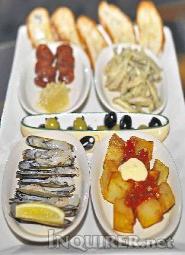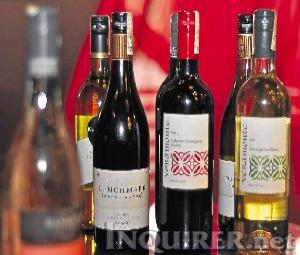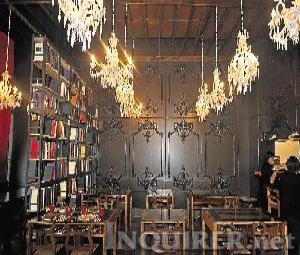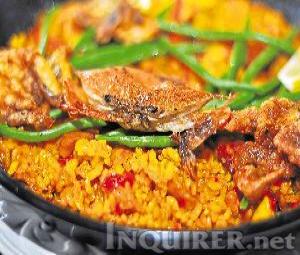 HE SPENT a month in Barcelona with his wife in 2009, checking out one tapas bar after another, trying to find which kind is acceptable in Manila. Tapas are appetizers—bite-size savory items that go well with beer or wine.
HE SPENT a month in Barcelona with his wife in 2009, checking out one tapas bar after another, trying to find which kind is acceptable in Manila. Tapas are appetizers—bite-size savory items that go well with beer or wine.
The Spanish people usually end the day with some munchies over a bottle of wine in a tapas bar.
Gilbert Pangilinan is the chef behind Kai, a Japanese fusion restaurant in Greenbelt 4 that became known for its innovative dishes.
And now Cerveseria is getting the buzz for its tapas, paella, Iberian chicken, cochinillo—and its cozy dark wood interiors that replicates a library. Another of Ricco Ocampo’s bright ideas, it echoes the small design-maverick restos of the Chelsea Meat Packing district in New York.
Pangilinan also operates a catering business specializing in Japanese food. But he can also do a filling Spanish spread. Spanish food, he said, is very similar to Filipino food—both are rich but with a sweet tinge, often simmered until a thick sauce comes out. One thing is a must for good Spanish food: excellent olive oil.
“I love Spanish food, and most Filipinos love to drink, so a tapas bar sounded like a good idea,” he said.
Pangilinan came up with the tapas menu for the Filipino palate, but still done the Spanish way—fragrant, usually with paprika, tomatoes, onion. The list: Pan con Tomate or toast with tomato; Setas Shimeji Fritos or fried Shimeji mushrooms with garlic aioli; Shitake Mushroom in Spicy Tomato Sauce; Patatas Bravas or potatoes in spicy tomato sauce and aioli; Croquetas de Queso de Cabra or goat cheese croquetas; Salpicao or tenderloin beef and garlic.
Pangilinan’s favorites include Huevos Rotos con Tocino or fried string potatoes, eggs and bacon, and Pimientos de Padron or whole Grilled Green Peppers—a tricky plate where only one of 10 pieces is spicy.
But it can’t be just all appetizers since local dining usually involves families who need “real food,” so he came up with his signature paellas.
Paella fiesta
There’s Paella Cerveseria with bacon, chorizo, chicken, shrimps, squid and soft-shell crab; Paella Negra with squid, shrimp and salmon belly; and Paella Vegetarian with potatoes, asparagus, carrots, bell pepper, shiitake and French beans. All are good for three to four servings, although a big eater can easily finish an entire paellera.
A good paella is cooked for just around 20 minutes and should be just an inch thick. You have to let it crust up a bit to get that sticky, slightly burnt base that you’d scrape from the bottom. “Tutong is what makes it taste good,” he said, laughing.
For those who don’t mind extra calories, a must-try is Cochinillo or roasted suckling pig with really crispy skin and juicy, tender meat which can be ordered whole, half or 1/6.
Other choices are Salmon al Horno or herbed baked salmon; Lubina Asada con Chorizo y Almejas or roasted local sea bass; Chorizo and Clams; Spicy Prawns Thermidor; Pollo Iberico or whole Iberian chicken. 
Kid-friendly pastas are Fideos with bacon, chorizo, chicken, shrimps, squid and soft-shell crab; Pasta con Chorizo y Almejas with chorizo and clam; Pasta con Chorizo y Salsa de Tomate with Tomato and Chorizo Pasta; and Pasta en Crema de Champiniones or cream mushroom pasta.
Modern ‘tapas’ bar
A typical tapas bar in Barcelona is pretty much like Cerveseria: dim, cozy, relaxed, but often dingy since it’s customary for diners to just throw food wastes on the floor.
The Cerveseria in Greenbelt perhaps could be categorized as a modern tapas bar: The interiors consist of heavy wood with baroque details; a bright red curtain hangs by the glass walls; there’s a steel frame bookcase with old-school hardbound books with surprise bottles of wine in between them. Sexy bossa nova music plays during afternoons.
An interesting accent are the iron-wrought chandeliers which look like candelabras with candle drippings —they are, in fact, candle drippings. Designer and co-owner Ocampo, who came up with the whole Spanish-romantic-vintage theme, had candles melted on them to achieve that effect, although LED lights are used now. The only way to clean those are to “re-drip” it with more candles, Pangilinan said.
The wood dining tables were made in Pampanga, chef Pangilinan’s province. They have glass tops baring “laminated” strips of black lace. There’s a drawer from where one can get plates and cutlery. The plates are in solid colors like graphite and off-white, and are offset by red thick crystal glasses. 
Wine buffet
Cerveseria’s façade could look intimidating, so Pangilinan introduced a come-on: happy-hour, with cheaper beer and wine buffet, at P588 per head.
“Since we recently opened, diners are usually expats who are familiar with tapas bars, some families on weekends and Makati office workers,” he said. “We wanted to jazz it up so DJ’s spin on Saturdays, playing hip-hop, ’80s, house tunes to give the restaurant a fun party feel.”
If you have some more room for dessert, there’s Canonigo, Crema Catalana, Churros con Chocolate, Caramelized Banana with Raspberry Ice Cream and Rice Pudding with Coffee Ice Cream.
Pan Con Tomate
4 pc sliced ciabatta or crusty bread
1 garlic clove
Extra-virgin olive oil
Ripe tomato cut in half
Salt
Grill bread. Rub with garlic and drizzle with olive oil.
Rub the tomato on the grilled bread. Sprinkle with Salt.
Serves four.
Nylon Clams
in White Wine
1 k nylon clams
1 head garlic, cut in half across
2 pc bay leaf
300 ml dry white wine
1 pc jalapeño pepper
2 tbsp extra-virgin olive oil
Serves four.
 Put everything in a saucepan, cover and steam over medium heat until clams open. Discard unopened clams.
Put everything in a saucepan, cover and steam over medium heat until clams open. Discard unopened clams.







































